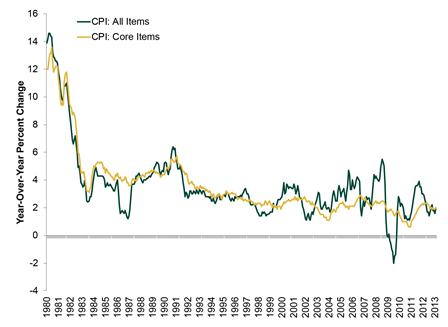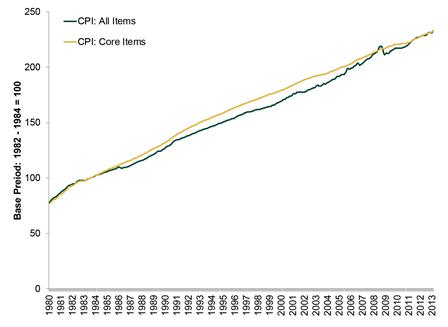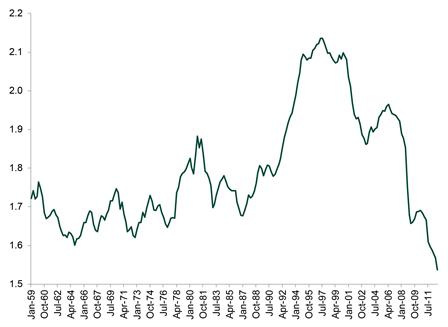Personal Wealth Management / Economics
Inflation Nation?
Consumer prices ticked up in February, but inflation’s still tame—and likely remains so awhile.
Inflation jitters resurfaced Friday, when the BLS reported consumer prices jumped 0.7% m/m in February—the biggest monthly increase since June 2009. In our view though, several factors suggest materially higher inflation isn’t a risk for now.
For one, a 9.1% rise in gas prices drove the headline jump. Core prices, which strip out food and energy—and are the Fed’s preferred inflation gauge—rose only 0.2% m/m. And year-over-year inflation remains very tame. Core and headline CPI are at 2% y/y, which is low by historical standards. (Exhibit 1)
Exhibit 1: Y/Y Changes in Headline and Core CPI, 1980 - 2013
Source: Bureau of Labor Statistics.
Folks often suggest using core CPI to measure inflation is somehow cheating. After all, when food and gas prices rise, it certainly eats into our wallets. But food and energy prices are volatile—they swing up and down quite a bit, which can obscure broader trends. Over time, however, core and headline CPI end up in the same place (Exhibit 2). (If this chart looks scary, remember: GDP and household wealth have also made astronomical gains over this period—prices didn’t rise in a vacuum.)
Exhibit 2: Headline and Core CPI Values, 1980 - 2013
Source: Bureau of Labor Statistics.
Stripping out the volatile components simply gives the Fed a more accurate view of broader long-term price trends. Plus, food and energy wobbles often have little if anything to do with monetary policy—and inflation, lest we forget, is always and everywhere a monetary phenomenon. If the Fed were to base monetary policy on the headline CPI rate, they’d likely take a more short-term approach, and policy would be heavily influenced by category-specific supply factors—crop shortages and surpluses, oil supply bottlenecks and the like.
For example, corn prices have occasionally risen because the ethanol mandate limits the amount of corn available for feedstock and foodstuffs, making beef and other corn-dependent foods pricier. That’s a regulatory consequence, not an inflationary trend. Droughts can also impact food prices in the near term—a weather issue, not monetary. But these category-specific price increases are often out of sync with broader price trends. Looking back at Exhibit 1, if the Fed based policy on headline CPI, they might have been tempted to tighten in summer 2008, which would have made the financial panic’s deflationary impact even more pronounced. Or they might have tightened in late 2011 and early 2012, when money was already barely moving.
Looking ahead, volatility in the price of individual goods almost surely continues. That’s true even in core categories—and it’s not necessarily bad. Consider smart phones. They’re more expensive now than a few years ago, but that’s because you’re getting 64 GB of memory and a 4G LTE data connection instead of 8 GB and the wireless equivalent of dialup. This is a productive price increase and most certainly not inflation.
Broad inflation—across the board price increases caused by too much money chasing too few goods—should remain benign. Yes, the Fed has increased money supply by over 250% and counting since late 2008, but that money’s not doing much chasing. The velocity of money—how quickly it changes hands—is at a generational low. (Exhibit 3)
Exhibit 3: M2 Money Velocity
Source: St. Louis Federal Reserve.
As long as banks don’t have incentive to start lending enthusiastically, money likely continues moving at a glacial pace. With the Fed’s contractionary quantitative easing (QE) continuing indefinitely, likely keeping the yield curve (and banks’ potential operating profits) flat, banks probably keep credit tight.
That’s a pity for the economy—a faster flow of money would likely boost growth. We’d rather the Fed end QE so firms can access more capital to expand their businesses. In the meantime though, since the private sector’s managing to eke out ok growth despite QE, we suppose low inflation risk is a decent consolation prize.
If you would like to contact the editors responsible for this article, please message MarketMinder directly.
*The content contained in this article represents only the opinions and viewpoints of the Fisher Investments editorial staff.
Get a weekly roundup of our market insights
Sign up for our weekly e-mail newsletter.

You Imagine Your Future. We Help You Get There.
Are you ready to start your journey to a better financial future?

Where Might the Market Go Next?
Confidently tackle the market’s ups and downs with independent research and analysis that tells you where we think stocks are headed—and why.








